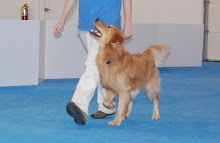First off...to further promote:
http://goclickchallenge.wordpress.com/
Read/watch and enjoy. Join in and share your training too. Laugh at my attempts to quickly train varied behaviors. Be amazed by the successes of others!
**********************
Now to the technical part of today. I was recently asked about my teaching process. And I felt like I gave a really incomplete answer. Yesterday however, while I was listening to an explanation of the "Delta Rule" for learning, I was able to use parts of that for how to explain my thought process when teaching.
http://en.wikipedia.org/wiki/Delta_rule
For everything we do, I have a picture of the "Ideal response". I tend to ask students to "show me where you are at". I compare that to the ideal, and note the differences. From there, I look at those differences and pick which one is likely to be best to first modify (Remember, for "Good Training" we modify only one thing at a time!). We do a few repetitions together and I give the student a couple of minutes to work at that level before we make additional modifications until we are at the "Ideal Response."
The differences can be what the dog is doing or what the handler is doing. Maybe I want the handler to keep hands at side ("Hands at side. After the click finishes, move your hands." Maybe I want the dog to sit right away ("If he pauses...move away and then try again.") Maybe I want the treat to be delivered under the dog's chin "Feed head straight, chin tucked [yes...that's two...shh]." Maybe I want one cue only "Sit once, then silence." There are four things that all need to be changing to improve the behavior of "Sit." If I gave all four to a student, s/he (and I!) would be overwhelmed.
I look at the priorities of each one to decide which is the most important right away. The order can depend on the dog/handler students, their abilities, and goals. For an average team... here are my thoughts:
Hands at side: This is important regardless of competition goals or pet training goals. This also tells me I should have caught this earlier too. This will impact the handler on all behaviors.
Latency: We want the dog sitting right away. This is important but may be fixed as we address these other issues. If he's not attentive until he hears the owner's hand in the treat bag...fixing the first issue may fix this.
Feeding Position: This is important with a bouncy young dog, less so with a more stationary dog.
One cue: Again, something that will impact the handler on everything. However, if the dog has lower latency [is responding right away], the owner may not feel the need to be cueing twice.
Going over this list... half the points point to fixing "hands at side" first. In TAG Teach language this could well be a "Value Added Tag Point." But fixing one thing, we are fixing half of all our problems! Addressing this first will be key.
I will explain and demonstrate about 5 times. Then let the handler take a few turns with me observing. I'll then work my way around to other students, and when I get back we'll work on our next piece, "Placement and presentation of reinforcer."
Now that was boring wasn't it.
Thursday, February 4, 2010
Subscribe to:
Post Comments (Atom)




No comments:
Post a Comment